
|
Roots In Sandusky The Sandusky & Interurban Electric Railway was incorporated in 1898 by the Everett-Moore syndicate, shortly after completion of the Lorain & Cleveland Railway. Thomas Wood, formerly manager of the Sandusky, Milan & Norwalk, and the People's Electric Street Railway of Sandusky, was put in charge of the new company. Within a year the ambitious S&I had consolidated Sandusky's two competeing streetcar lines, thus securing all franchises in the city, and chartered a thirty- two mile extension to connect with the Lorain & Cleveland in downtown Lorain. A branch south through Berlin Heights to Norwalk, to connect with the newly created Toledo, Fremont & Norwalk Railway, was added to the charter in 1899. These connections would make the S&I a central link in a new Cleveland to Toledo interurban system. The point at which the branch to Norwalk would split from the mainline was approximately one half mile north of the small town of Ceylon, and thus became known as Ceylon Junction. By 1899 the S&I had built as far east as Huron, where the issue of crossing the Huron River became a major obstacle. Service between Sandusky and Huron commenced in xxxx while grading of the right-of-way near Berlin Heights, Vermilion, and Lorain began in 1901. As explained on previous pages, Everett-Moore merged the Sandusky & Interurban, the Lorain & Cleveland, the Toledo, Fremont & Norwalk and the Sandusky, Milan & Norwalk into the Lake Shore Electric Railway in September 1901. The right-of-way between Lorain and Norwalk was completed in December and the Cleveland to Toledo connection was finally a reality. First Station During the hurried construction of late 1901, a dilemma arose over powering this section of the line. Direct current from the S&I power plant in Sandusky was insufficient, but the nearest source of alternating current was the TF&N's new power plant in Fremont. This being the only feasible source, a crude, cross-country transmission line was run from Fremont to Berlin Heights then along the tracks to Ceylon Junction. A wood frame building was quickly erected to serve as an electrical substation, ticket office, waiting room, and dispatch office. A permanent substation was built at Berlin Heights in 1903. The Ceylon Junction building was then used as a commercial AC substation for local residential power, and for switching high voltage AC coming from either Fremont or Beach Park. This building was destroyed by a fire in the early hours of August 11, 1911. The cause was unknown but believed to be the work of an arsonist. Second Station A new station was quickly built, this time constructed of concrete blocks, molded to resemble rough cut sandstone. The building measured 20 x 25 feet and featured large concrete plaques embossed with the name "Ceylon Junction" built into each end. Most curiously, a hexagonal tower, over twenty feet high and topped with a castle-like parapet, was built into the northeast corner of the station. Near the top, high voltage AC lines entered through holes fitted with glass insulators. Whether the tower housed some electrical equipment, was just an elaborate way of raising the power lines well above the cars, or served some other purpose, has never been accurately determined. Windows near the top suggest that personnel could ascend the tower by ladder or stairway. The bottom of the tower housed the dispatcher's office. Just as mysterious as its purpose, the exact fate of the tower is unclear. Electrical transformers were moved outdoors of all substations in 1925 after the fire at the Beach Park powerhouse, and it is commonly believed that the tower was dismantled at that time or soon after. The tower appears in one photo from the 1920's but is absent from all photos taken after 1930. Refreshment Stand The large farmhouse at Ceylon Junction was built several decades before the railway, but would later become the residence of George Otto. Born near Ceylon in 1880, George Otto saw the LSE near his home as a business opportunity. He opened a refreshment stand in a small wood frame building with an ornate curved roof in the narrow space between the old Lake Road and the LSE tracks. (Recall that at this time, Lake Road was on the north side of the LSE tracks. It would be moved to its present location in 1932, after severe erosion of the shoreline.) From here he sold candy, cigars, chewing gum, sandwiches and soft drinks to LSE riders and crews. Mr. Otto hired local teenagers to ride LSE cars with boxes of his goods to sell to the passengers. No doubt many riders making the long trip from Detroit or Toledo to Cleveland welcomed the opportunity for a snack. Although the end of the LSE meant an end to much of the customer base for Otto's refreshment stand he continued as a wholesaler to other local merchants and operated concessions at Crystal Beach in Vermilion until his death in March 1941. Operations For the first year of the Lake Shore's life Ceylon Junction wasn't much of a junction, as the route west to Huron and Sandusky was not yet in service. Construction between Ceylon Junction and Huron had been put on hold pending a resolution of the bridge situation at the Huron River. On November 15, 1902 the gap was officially closed and service between Ceylon Junction and Huron commenced. The bridge situation would not be resolved for another year, however, and passengers were required to cross the bridge by foot and transfer to another car for the trip to Sandusky. For several years the route south of Ceylon Junction to Norwalk was the only route available for Cleveland - Toledo traffic. In 1906 construction began on an extension from Sandusky to Fremont which would become the "northern" division for limiteds upon its opening on July 21, 1907. For the next few years limiteds would alternate using the northern and southern divisions, with local shuttle service operating on whichever division the limited did not use. Regular use of multiple-unit trains began in 1911 and with it the practice of splitting the trains between Ceylon Junction and Sandusky Junction near Fremont. In the case of a two car train one car would travel over each division. Three car trains often included a Detroit United Railway car for service to and from Detroit, or a Western Ohio car for service to and from Lima. In such cases a single LSE car would run over the northern division while the other LSE and the "foreign" car would take the southern division. On rare occasions a four car train is known to have been operated at the peak of the busy summer months, but trains over three units were never a regular site on the LSE. Detroit and Lima service ended in 1932, by which time multiple-unit trains had also become a thing of the past. The northern division through Sandusky then became the standard route for limiteds while the southern division was serviced by two Niles coaches which acted as shuttles from Ceylon to Norwalk and Norwalk to Fremont. Early in 1938 the southern division shuttles were augmented, then replaced, by Lake Shore Coach Co. buses with Ceylon Junction becoming the interurban/bus transfer point. Ceylon Junction Today Once the LSE was completely dismantled and all legal arrangements had been made to dissolve the company some of the right-of-way property reverted to its previous ownership. The Ceylon Junction station and the right-of-way south to the new Lake Road was merged with the property of the Otto family home. That right-of-way is now the private driveway leading to the house from Lake Road. A line of electrical poles, still operated by the Ohio Edison company, follows the old path of the LSE mainline and south from Ceylon Junction, across Lake Road, and toward the town of Ceylon. At Ceylon the Lake Shore Electric crossed over the Lake Shore & Michigan Southern Railroad on a steel trestle. Although the bridge was dismantled in 1939 the stone abutments at either end and the concrete footers for the supports can still be seen just west of Ceylon Road. For many decades the station building was used for storage and as a tool shed with various bits of LSE scrap, such as rails and ties, still lying nearby. But in recent years it has been thoroughly refurbished and restored by the current owner and is now rented as a beautiful and cozy cottage residence. A sign posted at the foot of the driveway warns potential visitors that this is private property. However, a phone number is given and permission is sometimes granted to see the station building if arrangements are made in advance. While the station building still stands, Lake Erie has not been as kind to the old Lake Road or Mr. Otto's refreshment stand. Severe erosion has washed away hundreds of feet of land including the road and the site of the refreshment stand. The amount of encroachment is quite startling when comparing vintage and modern photos of the area. Some views are impossible to reproduce today because the land from which they were photographed no longer exists. Large concrete blocks and jetties have since been placed along the shore to protect what remains. Thanks to the preservation of the current owners the Ceylon Junction station, now 100 years old, will live on and be appreciated for many years to come. |
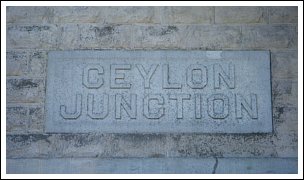
the Ceylon Junction station. (Drew Penfield photo) |
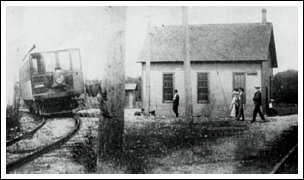
and simple wood frame building. (Dennis Lamont) |
|

original tower on the northeast corner. (Dennis Lamont) |
|
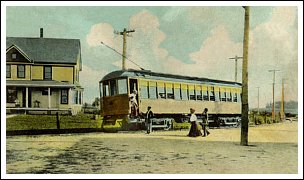
to the Otto farmhouse. (Dennis Lamont) |
|
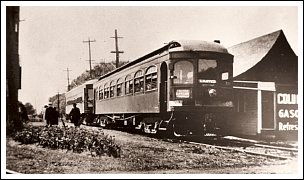
between 1915 - 1925. Note station tower at left. (Tom Bailey) |
|
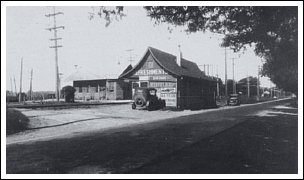
refreshment stand and the station. (Dennis Lamont) |
|
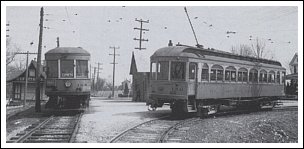
is exiting the station. (Ralph A. Perkin photo) |
|
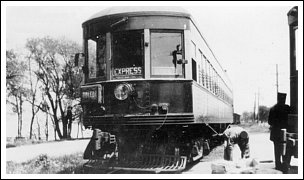
167 to the southern division shuttle. (Dennis Lamont) |
|

on a snowy winter day in 1937. (Karel Liebenauer photo) |
|
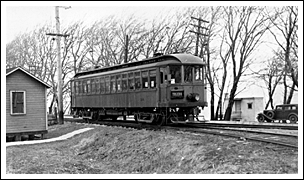
|
|
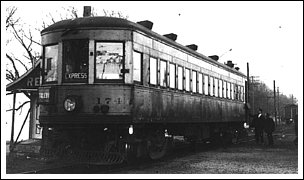
(Dennis Lamont) |
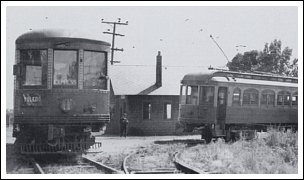
(Dennis Lamont) |
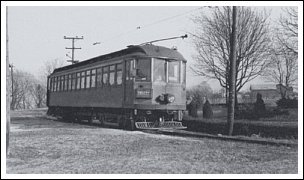
junction wye. (Dennis Lamont) |
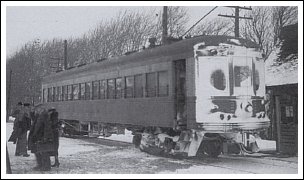
transfer in November 1937. (Ralph A. Perkin photo) |
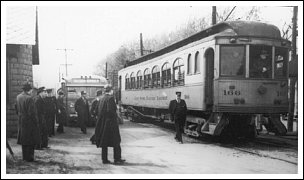
with the southern division shuttle bus. (Dennis Lamont) |
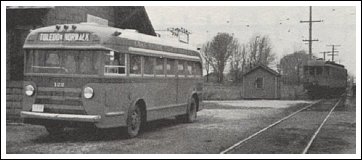
One of the last interurbans in the background. (Harry Christiansen) |
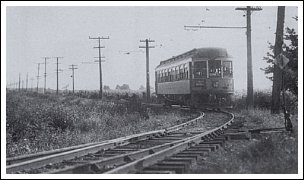
Junction wye in 1936. (Ralph A. Perkin photo) |

fresh fruit, approaches the junction. (Dennis Lamont) |
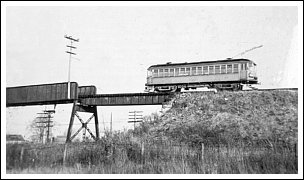
tracks at the town of Ceylon in 1934. (Dennis Lamont) |
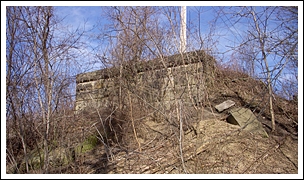
(Drew Penfield photo) |

|
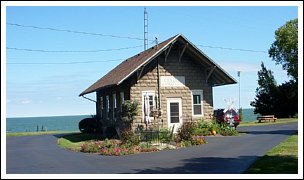
(Drew Penfield photo) |
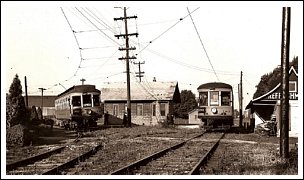
|
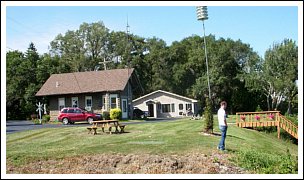
|
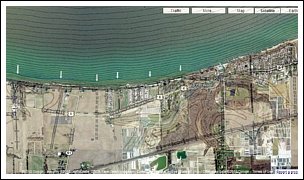
indicate amount of shoreline erosion. (Dennis Lamont) |

at left, pole line is LSE right-of-way. (Dennis Lamont photo) |

|
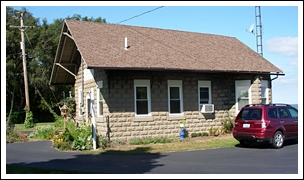
bottom of old tower. (Drew Penfield photo) |
|
|
|